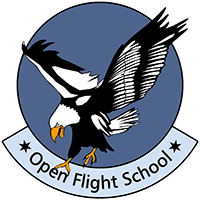Main Glossar
Currently sorted By last update ascending Sort chronologically: By last update
Charlie | |||
|---|---|---|---|
Charlie Time The planned landing time on a vessel. Often also used for landing ashore. Usually the expected end of the sortie. | |||
VSI | |||
|---|---|---|---|
RCDI | |||
|---|---|---|---|
AI | |||
|---|---|---|---|
Attitude Indicator The main instrument of understanding the aircraft‘s attitude with respect to earth’s surface. It is a gyro (or graphical representation) driven by either:
It is normally mounted centrally on an aircraft main instrument panel. It can be implemented as graphics within a “glass cockpit”. Further Information: Wikipedia | |||
OAT | |||
|---|---|---|---|
Outside Air Temperature The temperature of the air around the aircraft. Low temperature causes the air to be more dense and so appear as if the aircraft is flying lower when assessed on a Barometric Altimeter. Average Air Temperature at sea level for the ICAO Standard Atmosphere is 15° Wiki: Outside Air Temperature | |||
CAVOC | |||
|---|---|---|---|
CAVOK ist eine Abkürzung für Clouds And Visibility OK (zu deutsch Wolken und Sicht in Ordnung). Diese Abkürzung für eine Wetterbeschreibung wird in der Luffahrt verwendet. Damit werden gute Bedingungen für den Sichtflug ohne Einschränkungen gemeldet.Der Begriff wird unter anderem in ATIS-Meldungen, bei Meteorological Aviation Routine Weather Report (METAR) und Terminal Aerodrome Forecast (TAF) verwendet. Weitere Informationen: | |||
NOE | ||||
|---|---|---|---|---|
Die Abkürzung steht für Nap-of-the-earth und wird im deutschen als Konturenflug bezeichnet. Dies ist ein Flugmanöver bei dem Hubschrauber und militärische Flugzeuge dicht über dem Boden fliegen um eine Sichtung oder eine Radarerfassung zu vermeiden. Weitere Informationen: | ||||
FRAGO | ||||
|---|---|---|---|---|
Der Begriff FRAGO ist die Kurzform von Fragmentary Order und kann mit Einsatzbefehl, Ergänzungsbefehl oder Zusatzbefehl übersetzt werden. Damit wird eine Einheit über abweichende oder ergänzende Befehle zur OPORD (Operation Order) informiert. Es kann zum Beispiel kurz vor oder während einer Mission passieren, dass sich die Situation ändert und die Befehle der OPORD angepasst werden müssen. Der Befehlshaber gibt dann eine FRAGO heraus. Diese hat das selbe Format wie die OPORD, enthält aber nur die Abweichungen. Weitere Informationen: | ||||
OPORD | ||||
|---|---|---|---|---|
Dabei handelt es sich um die Abkürzung für Operation Order. Im deutschen werden die die Begriffe Operationsbefehl (Brigade und höher) bzw. Einsatzbefehl (Regiment und darunter) verwendet. Weitere Informationen: | ||||
VDI | |||
|---|---|---|---|
Vertical Display Indicator (dt.: vertikale Displayanzeige) Das VDI zeigt Lage- und Waffendaten an. Weiterführende Informationen:
| |||
HSD | |||
|---|---|---|---|
RIO | |||
|---|---|---|---|
Radar Intercept Officer (dt. etwa Radar Abfang Offizier) Der RIO ist in der F-14 das hintere Besatzungsmitglied. Standardmäßig werden die Aufgaben des RIO von einer von Heatblur entwickelten KI namens Jester übernommen. Im Multiplayer kann der RIO auch von einem Mitspieler gespielt werden, sofern er auch das Modul gekauft hat. Weiterführende Informationen: | |||
TIT | |||
|---|---|---|---|
Turbine Inlet Temperature (dt.: Turbineneinlasstemperatur) Die TIT ist die Temperatur der Gase nach der Brennkammer des Triebwerkes, bevor sie auf die Turbine treffen. Weiterführende Informationen:
| |||
AFCS | |||
|---|---|---|---|
STAB AUG | |||
|---|---|---|---|
Stability Augmentation (dt. etwa: Flug-Stabilisatoren) Die F-14 hat drei Flug-Stabilisatoren für Nicken, Rollen und Gieren. Weiterführende Informationen:
| |||
VV | |||
|---|---|---|---|
DLC | |||
|---|---|---|---|
Direct Lift Control (dt.: direkte Auftriebskontrolle) Das DLC ist ein System von Klappen die im Landeanflug verwendet werden können, um den Auftrieb zu verändern ohne den AOA zu beeinflussen. Gesteuert werden die Klappen über einen Schalter am HOTAS Steuerknüppel. Weiterführende Informationen:
| |||
TID | |||
|---|---|---|---|
Tactical Information Display (dt.: Taktische Informationsanzeige) Das TID ist ein Bildschirm in der zentralen Konsole des RIO. Die Anzeige kann auf dem HSD, mittels eines Schalters vom Piloten aus, gespiegelt werden. Weiterführende Informationen:
| |||
PVI-800 | |||
|---|---|---|---|
The PVI-800 is one of the two navigation systems of the KA-50. It has no graphical display. It operates independently of the ABRIS, the only exception being the graphic representation of a navigation target of the PVI-800 in the ABRIS as a blue square. The PVI-800 is based on the INU of the KA-50. The PVI-800 delivers the data to the route autopilot of the KA-50. Further Information: KA-50 Black Shark Basic Course (DCS) / Cockpit Instruction / Cockpit Overview / RP | |||
